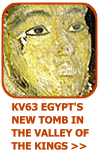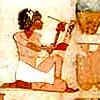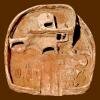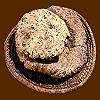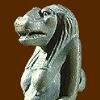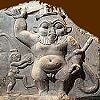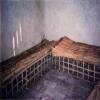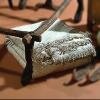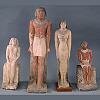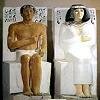|
|
||||||||||||||||||||||||||||||||||||||
|
|
Topics in this section: work and trade | leisure activities | hunting and fishing | food and drink | health and wellbeing | dress Daily life throughout the centuries in Ancient Egypt revolved around the Nile and the fertile land along its banks. The annual inundation enriched the soil and brought good harvests and wealth to the land. People generally built their own mudbrick homes, grew their own produce, and traded in the villages for food and goods they could not produce themselves.
The home ... Central to life in Ancient Egypt was the home. Homes were built using mudbricks made from chopped straw mixed with mud from the Nile and baked in the sun. Depending on how wealthy and elaborate you were, the inside of your home would be painted with colourful scenes of everyday life. A simple earthen floor would be covered with reed mats, and woven sticks and palm rafters made up the ceilings.
Many homes had stairways leading to a flat roof that contained a vent for catching cool breezes, together with storage bins or small grain silo. Often during the hot months, the Egyptians wood cook, eat and sleep on their roofs, and would usually eat meals sitting on a bench with reed mats. How the wealthy used to live ...
Homes of the wealthy often included a bathroom of sorts, which was actually a recessed room with a square slab of limestone on the corner. Servants would douse you with water whilst you stood on the slab, and the water would empty out into a bowl in the floor below, or through an earthenware channel in the wall.
Family life and education ...
Education was expensive, and it was usually only boys who went to school, from around the age of five until they reached their teens. If you couldn't afford to send your son to school, then when he was considered old enough, he would go to work with his father and learn his trade. Schools were usually attached to temples and government offices, and children were taught by the priests. Young students learned hieratic script, writing on broken bits of pottery or wooden boards. Papyrus was considered far too expensive just to practice upon! Older students studied hieroglyphs, maths, history, languages, geography, astronomy and law, as well as gymnastics and good manners! Ancient Egyptian society was basically divided into four classes. The upper class included the government officials, nobles, and priests. The middle class included the scribes, skilled craftsmen, tradespeople, teachers, artists, and soldiers. The peasants, mostly farmers, labourers, and servants made up the lower class, which was the largest class. Finally the slaves (mostly foreign captives) made up the bottom class. Find out more by clicking on a topic below: work and trade | leisure activities | hunting and fishing | food and drink | health and wellbeing | dress
|
|||||||||||||||||||||||||||||||||||||

|
||||||||||||||||||||||||||||||||||||||
|
||||||||||||||||||||||||||||||||||||||





